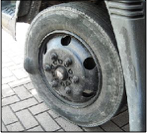For the past couple of months, Tim [Chief Car Observer] and I have been testing the Fit2Go Michelin Tyre Pressure Monitoring System [TPMS].
Increasingly such technology is fitted as standard on new vehicles, but for those that aren’t equipped, this is an excellent investment.
This wireless system is the epitome of “plug and play”, simply inflate your tyres to the correct pressure, fit the TPMS valve caps and LCD screen and off you go. The whole process took less than 3 minutes. Once fitted, the unit displays the pressure of each tyre, in either psi or bar.
Riders/drivers will see a low-pressure warning if a tyre becomes under-inflated by 15%, an enhanced alert when the pressure either drops by 25%, or if over-inflated by 35%+. There are also alerts for high tyre temperatures or fast leakage (at least 2 psi per minute).
Overall, we were thoroughly impressed with the design and quality of the product. It was very simple to install and [most importantly from a safety perspective] accurate. I compared the LCD readout with a calibrated gauge, and they were identical. Similarly, it was reassuring to see the pressures rise as the tyres heated up, in my case, both front and rear on my Honda CBR500R increased by ~3psi after ~1.5 miles.
My only grievance with this product is the fact that the wheels must be moving before the pressures are displayed. This is frustrating should you need to return to the shed/garage to top up!
We would both recommend this product and consider the £80 retail price good value for money especially when you consider the saving in tyre wear and fuel consumption, and that is before you factor in the additional peace of mind this product brings.
CAMADAR members who would like to use the system can benefit from a 10% discount by using the discount code CAMADAR10 when checking out on the https://fit2gotpms.com website.
Scott Walker – Head of Motorcycle Section.




 will give us a presentation on his life and work as a DVSA Vehicle Examiner – with videos and photos of defects on all types of vehicles, and other dangers, that he has discovered.
will give us a presentation on his life and work as a DVSA Vehicle Examiner – with videos and photos of defects on all types of vehicles, and other dangers, that he has discovered.

 Veteran staff and apprentices work together to build brand new 1955 Jaguar XKSS ‘continuation’ cars, using serial numbers earmarked for the original production versions, and rebuild the ‘Reborn’ Land Rover Series 1, from £75,000, Range Rover Classic, from £140,000, and Jaguar E-type Series 1, from £295,000. Two full-time buyers scour the world to buy suitable project cars for restoration and exceptional cars not requiring restoration from as far afield as Australia, New Zealand, South America, Asia and India.
Veteran staff and apprentices work together to build brand new 1955 Jaguar XKSS ‘continuation’ cars, using serial numbers earmarked for the original production versions, and rebuild the ‘Reborn’ Land Rover Series 1, from £75,000, Range Rover Classic, from £140,000, and Jaguar E-type Series 1, from £295,000. Two full-time buyers scour the world to buy suitable project cars for restoration and exceptional cars not requiring restoration from as far afield as Australia, New Zealand, South America, Asia and India. DVLA figures tell us that over five million drivers have passed their test since that date, but only 1.2% have passed a towing test to upgrade to a B+E licence. Just by towing a typical family caravan with an SUV, a young driver with only a B licence could be risking a £1,000 fine and three to six penalty points.
DVLA figures tell us that over five million drivers have passed their test since that date, but only 1.2% have passed a towing test to upgrade to a B+E licence. Just by towing a typical family caravan with an SUV, a young driver with only a B licence could be risking a £1,000 fine and three to six penalty points.

